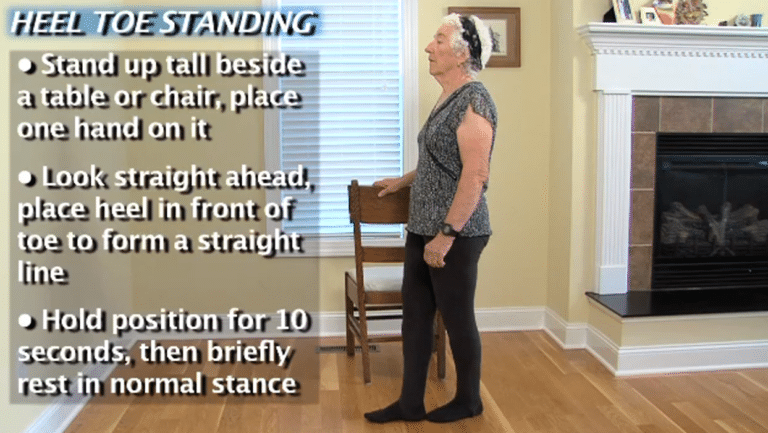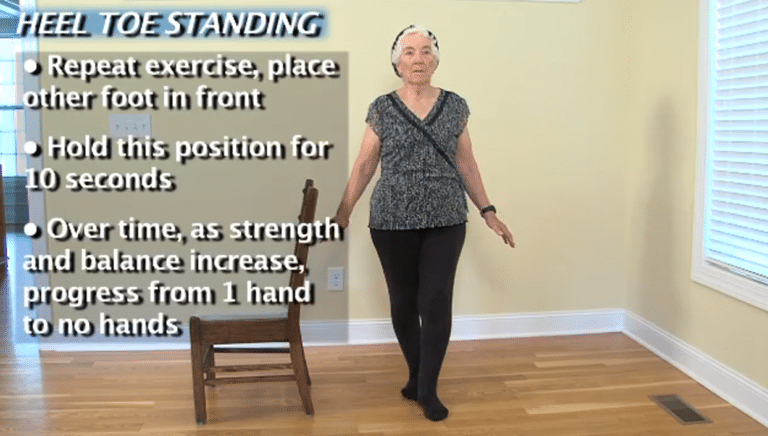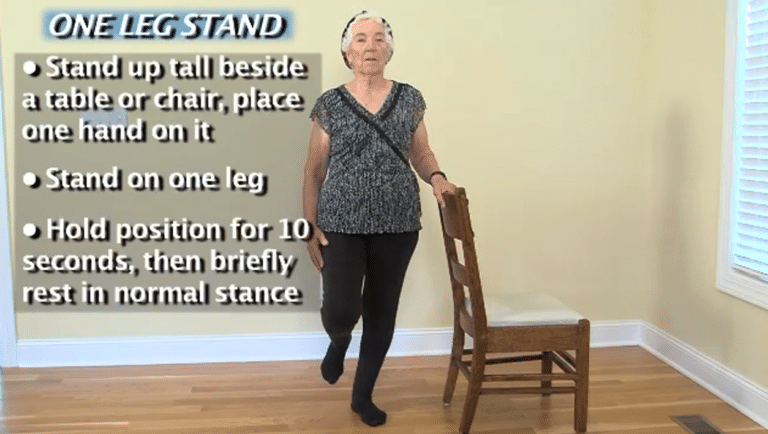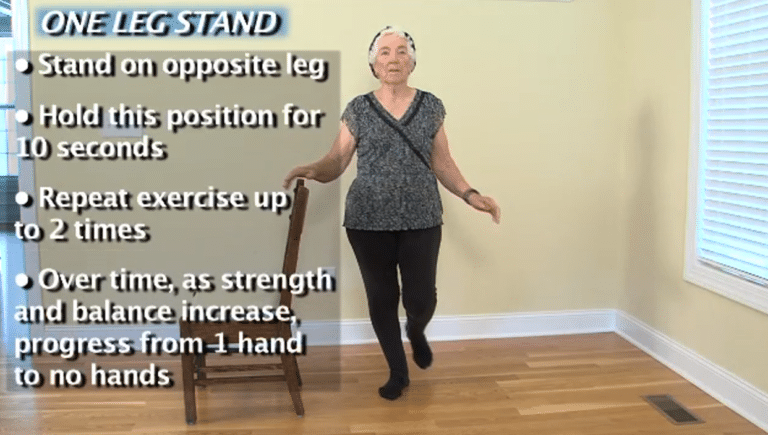We Declared Our Independence
On July 4, 1776, thirteen English colonies claimed their independence from Great Britain. This event led to the formation of the United States. Each year on the fourth of July, also known as Independence Day, Americans celebrate this historic event.1 But our celebrations this year will be far different than in years past. The COVID-19 pandemic has limited our ability to gather in great numbers. This has led to the canceling of parades and fireworks across the country.
So while we celebrate the Fourth of July in a more subdued fashion this year, I am going to turn your attention to four tips to help you stay independent in your living for years to come.

Declare Your Independence
In 2016, 83.4% of people over the age of 65-years were reportedly living alone.2 Furthermore, 21 percent of North American adults would prefer to maintain their current living situation after turning 80 years old. This is the highest ranked desire compared to all other choices, including moving to an independent care facility (over 55-community).
With more of you preferring to stay in familiar surroundings, to stay at your current home, and to “age in place,” it becomes paramount that you declare that you will stay independent. But a simple statement of your desire to stay independent is just the beginning.
You will need to take some decisive action to make sure that you remain strong enough, safe enough, and healthy enough to reach your goal.

Four Tips to Keep You Independent
So in honor for the Fourth of July, I’ve put together 4-tips to help you stay independent as you age.
While you might think that you’re too young to worry about this, healthy, independent living is a long term goal with no specific age as its starting point. That means that you can start now to live a healthier life, but that when you reach the goal of living independently at age 80, you do not get to stop doing what got you there. You might consider this an “infinite” goal. And contrary to the ads that say so, there is not a 5-minute fix…especially for aging.
If you do stop, then the goal might actually slip away from you. You could lose the independence that you fought long and hard to keep.
So, without further ado:
“…to stay in familiar surroundings, to stay at your current home, and to “age in place,” it becomes paramount that you declare that you will stay independent…”
Tip #1: Keep Your Legs Strong
I had a patient that consulted with me about her shoulder problem. She reported that she had pain in her shoulder that interfered with swimming, which she did to maintain her health and fitness. But on further questioning, it turned out that swimming did not cause her shoulder pain.
She had a fall when walking at the beach. When she landed, she broke her fall by putting her hands down in front of her. Since that time, she had her shoulder pain.
Now, she obviously had some trauma to the shoulder, which caused her shoulder to hurt. But I had to go one step further with her questioning.
“Why did you fall?”
She reported that her legs got tired when walking on the beach, and she “simply tripped.” “It happens pretty frequently for me,” she went on to say.
“So we need to strengthen your legs, not fix your shoulder,” I said. “Because without stronger legs, you are more likely to fall, and you will hurt your shoulder again.”
I’m not above appealing to your vanity to get my point across, either.
Let’s face it, you won’t be too embarrassed if you can’t swim as fast as you once did, or if you can’t throw a 100-mph fastball anymore.
But you will care if you cannot stand up from the commode! Who among us wants to call for help to stand up from the toilet? Not me…!
Functionally, your leg strength is paramount to your staying independent!
Try these two exercises to keep your legs strong:
Chair Squats
- Begin in a standing upright position in front of a chair.
- Lower yourself into a squatting position, bending at your hips and knees, until you lightly touch the chair. Return to the standing position. Repeat for up to 10 repetitions morning and evening.


Step Ups
- Begin in a standing upright position with a small step or platform in front of you and your hands resting on a counter.
- Step up onto the platform with one foot then follow with your other foot. Return to the standing position. Repeat for up to 10 repetitions on each leg morning and evening.
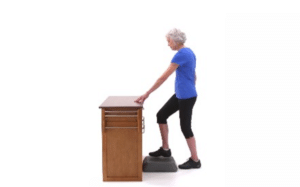
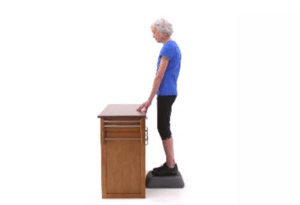
Tip #2: Work on Your Balance
Along with leg strength, being able to maintain your balance is also a top priority.
One in four adults over the age of 65 years will have a fall each year. Falls are the most common cause for both fatal and non-fatal injuries in the elderly population.
And the psychological toll is even longer lasting than the physical injury. Many people after suffering a fall fear having another fall. This leads to limiting physical activity and social engagement, which may lead to further physical decline, social isolation, and depression. In fact, the fear of having a fall actually increases the likelihood of falling.
Falls are often preventable with a little bit of balance practice. Balance is a skill that you can improve, it is not something that you are born with…so no excuses!
Just as you learned to hand write legibly (at least some of us are legible) by practicing, you can also get better balanced by practicing. But remember, this is an “infinite goal” of becoming better balanced, not a goal you reach and then stop working toward.
Practicing balance will make you more confident, but most importantly, it makes keeping balance more automatic for you. That is the key, really. To have your body automatically keep your balance without you thinking about it…that way you can walk and have a conversation at the same time!
Try these two exercises to improve your balance:
Heel-to-Toe Stance
- Stand tall next to a table or chair keeping head and eyes looking straight forward.
- Place one foot directly in front of the other (Heel-to-toe). Hold position for 10 seconds. Repeat with opposite foot in front as well. Practice this in the morning and evening.
- As balance and strength improve, progress to less balance assist with hands on chair back/counter.
Single-leg Stance
- Stand tall next to a table or chair keeping head and eyes looking straight forward.
- Stand on one leg, holding position for 10-seconds. Practice this on each leg morning and evening.
- As balance and strength improve, progress to less balance assist with hands on chair back/counter.
Tip #3: Keep Walking
As your strength and balance improve, your confidence will also improve. Now is the time to work on increasing your ability to walk for a distance that allows you to do what you want.
If you are just getting started with going for a longer walk, then try it this way.
Start from home and walk one quarter of the total time you are shooting for away from home. Turn around and walk back toward home. As you pass home, you are half-way through your walk. Continue for another quarter of the time, and turn back to home.
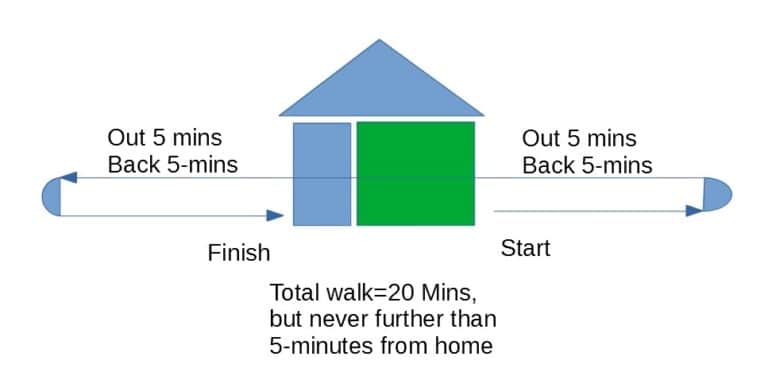
This way you are never too far from home if you begin to feel tired or have any other trouble.
Walking with a friend is also a great idea remain safer…and to have someone to help with motivation to keep you faithful to walking regularly.
Tip #4: Eat and Drink Regularly
Did you know that the risk of losing your ability to live independently goes up significantly after a person suffers a hip fracture?
And what is the major cause of hip fracture? Yep, you guessed it….having a fall.
So what does that have to do with eating and drinking?
After people suffer falls, the fear of another fall can prevent them from getting up and walking at home. In fact, many folks will limit their drinking so they don’t need to get up to walk to the bathroom. That fear of falling is even more compounded if the person had their initial fall in the bathroom.
That same person might also not stand in the kitchen to prepare a meal either.
Not having enough to eat or drink is a recipe for malnutrition. Malnutrition can result in poor bone healing, low energy, depression, and poor cognition.
Without getting adequate nutrition, independent living becomes impossible.
Summary
If your goal is to remain independent in your living for the rest of your life, the time to start working toward that goal is now. These four tips are a great way to start your journey toward a lifetime of independence.
1-Get your legs stronger.
2-Practice your balance.
3-Walk more.
4-Eat well…and don’t forget to drink water!
So this Fourth of July, declare your own independence and start doing the work that will help prevent a loss of independence throughout your lifetime.
Stay healthy, stay safe, and stay physically active!
For more information on balance exercises and some progressions, see: https://www.med.unc.edu/aging/cgec/exercise-program/videos/balance-exercises/
Archives
- March 2024
- February 2024
- January 2024
- October 2023
- September 2023
- April 2023
- December 2022
- November 2022
- October 2022
- August 2022
- July 2022
- June 2022
- May 2022
- March 2022
- January 2022
- April 2021
- February 2021
- January 2021
- September 2020
- August 2020
- July 2020
- June 2020
- April 2020
- January 2020
- September 2019
- June 2019
- May 2019

